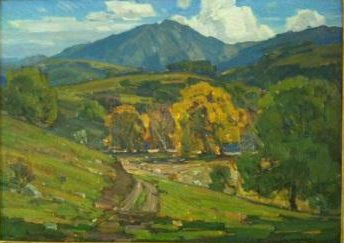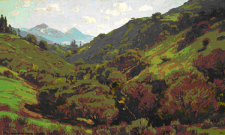
William Wendt
American, 1865-1946
A Bend in the Road, n.d.
Oil on canvas
20 x 28"
Private Collection

Photograph of William Wendt, n.d.
"Here away from conflicting creeds and sects, away from the soul destroying hurly burly of life, it feels that the world is beautiful; that man is his brother; that God is good." - William Wendt

William Wendt, Landscape, 1912
COMMENTS
(Comments on Landscape, 1912)
William Wendt moved to Los Angeles from Chicago in 1906 at the age of forty-one. His vision, style, and expression—a rigorous and disciplined mix of academicism and impressionism—would change little during his California years. Indeed, it was the combination of his consistency, confidence, experience, and impressive painting skills that almost instantly made Wendt the leader of Southern California’s emerging visual arts culture. From the outset, his authoritative landscape paintings—vistas that all Southern Californians knew—celebrated clarity and solidity, cleanliness and truth.
Wendt’s Landscape of 1912 is typical of how successfully the artist blended visual strategies associated with the Hudson River school—the epic, distant view rendered with structural precision—with the illuminated palette of impressionism. Wendt shared the belief held by early American painters that evidence of divine plan and purpose was woven into the landscape, and his art is marked by his careful transcription of natural scenery. For Wendt, the facts of Creation were truth. In his Landscape, the largesse and grandeur of California is captured by a succession of overlapping hills receding into a blue-gray distance: this, the artist effectively communicates, is a vast and effulgent landscape. The open, blue sky and the interlocking permutations of green suggest healthfulness and, by extension, optimism.
Wendt also embraced the vitality and sensuality offered by impressionism’s direct transcription of outdoor light and color, as these phenomena were equally true. Landscape’s solid forms are layered with bright, briskly applied strokes derived from his ongoing outdoor study. Not fully academic nor fully impressionistic, William Wendt’s genius lay in his ability to synthesize aspects of both traditional and more contemporary modes of painting, and keep his focus on what he believed to be the role of the artist: to reveal the essential goodness of nature. His single-minded devotion to this task made him one of Southern California’s most popular and influential artists in the first half of the twentieth century, and his legacy continues to resonate into the present time.
- Will South, Chief Curator for The Dayton Art Institute
